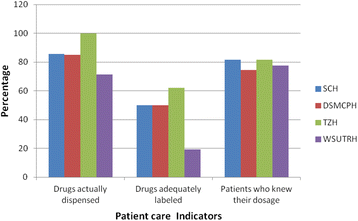Assessment of drug use patterns in terms of the WHO patient-care and facility indicators at four hospitals in Southern Ethiopia: a cross-sectional study
- PMID: 27832773
- PMCID: PMC5103396
- DOI: 10.1186/s12913-016-1882-8
Assessment of drug use patterns in terms of the WHO patient-care and facility indicators at four hospitals in Southern Ethiopia: a cross-sectional study
Abstract
Background: Patient-centered care is now the goal for virtually all healthcare systems. The aim of this research was to evaluate the patient care quality in regard to drug dispensing in four hospitals in southern Ethiopia namely Wolaita Sodo University teaching and referral hospital (WSUTRH), Tercha zonal hospital (TZH), Sodo Christian hospital (SCH) and Dubo St. Mary's Catholic primary hospital (DSMCPH).
Methods: A cross sectional study was conducted by using the WHO patient care and facility indicators between September 10 and October 20, 2014. Patients who visited the outpatient departments of the four hospitals were selected by systematic random sampling method and interviewed. In total 384 patients were selected based on a rough estimate of proportion of patients visiting to the four hospitals. Facility indicators including the availability of essential drugs list (EDL), national drug formulary, standard treatment guideline (STG) and key drugs were evaluated. Descriptive statistical calculations were performed using SPSS® version 20.0 software.
Result: The mean number of drugs was in the range between 1.9 ± 0.9 to 2.2 ± 2.0. The mean consultation time range was found to be 4.2 ± 1.6 to 4.9 ± 5.0 min whereas the mean dispensing time was ranged from 96.1 ± 52.0 to 152.3 ± 47.6 s. The overall mean number of drug prescribed for the four hospitals was 2.0 ± 1.2 and the mean percentage of medications actually dispensed in the hospitals was thus calculated to be 86.3. The mean percentage of medications clearly labeled was 45.4. Patients who knew their dosage forms accurately were 78.8. Among the four hospitals evaluated only one hospital (25 %) had at least a copy of the Ethiopian essential drug list (EDL), standard treatment guideline for hospitals and drug formulary. The mean availability of key drugs in the hospitals was found to be 65.7 %.
Conclusion: The result of the present study indicates that the patient consulting time, medications labeling and availability of key drugs in the hospitals are inadequate. The medication labeling practice in the four hospitals is unacceptably low. These patient care indicators need a special attention for improvement.
Keywords: Drug use patterns; Drugs; Ethiopia; Facility indicators; Patient care indicators.
Figures
Similar articles
-
Systematic review and meta-analysis of medicine use studies in Ethiopia using the WHO patient care indicators with an emphasis on the availability of prescribed medicines.BMJ Open. 2022 Mar 21;12(3):e054521. doi: 10.1136/bmjopen-2021-054521. BMJ Open. 2022. PMID: 35314470 Free PMC article.
-
Evaluation of rational drug use based on World Health Organization core drug use indicators in selected public hospitals of eastern Ethiopia: a cross sectional study.BMC Health Serv Res. 2017 Feb 23;17(1):161. doi: 10.1186/s12913-017-2097-3. BMC Health Serv Res. 2017. PMID: 28231833 Free PMC article.
-
Assessment of Prescription Completeness and Drug Use Pattern in Tibebe-Ghion Comprehensive Specialized Hospital, Bahir Dar, Ethiopia.Biomed Res Int. 2020 Oct 19;2020:8842515. doi: 10.1155/2020/8842515. eCollection 2020. Biomed Res Int. 2020. PMID: 33134391 Free PMC article.
-
Assessment of medicines use pattern using World Health Organization's Prescribing, Patient Care and Health facility indicators in selected health facilities in eastern Ethiopia.BMC Health Serv Res. 2016 Apr 23;16:144. doi: 10.1186/s12913-016-1414-6. BMC Health Serv Res. 2016. PMID: 27106610 Free PMC article.
-
The Pattern of Medicine Use in Ethiopia Using the WHO Core Drug Use Indicators.Biomed Res Int. 2021 Dec 24;2021:7041926. doi: 10.1155/2021/7041926. eCollection 2021. Biomed Res Int. 2021. PMID: 34980999 Free PMC article.
Cited by
-
Analysis of the pattern of drug use using WHO core drug indicators among general OPD patients in rural Puducherry.J Family Med Prim Care. 2024 Nov;13(11):5193-5197. doi: 10.4103/jfmpc.jfmpc_922_24. Epub 2024 Nov 18. J Family Med Prim Care. 2024. PMID: 39723006 Free PMC article.
-
Evaluation of Drug Use Pattern in Emergency Department of Dilchora Referral Hospital, Dire Dawa, Ethiopia.Emerg Med Int. 2020 Feb 25;2020:4173586. doi: 10.1155/2020/4173586. eCollection 2020. Emerg Med Int. 2020. PMID: 32185081 Free PMC article.
-
Comparing pharmacy practice in health facilities with and without pharmaceutically trained dispensers: a post intervention study in Tanzania.J Pharm Policy Pract. 2024 Apr 2;17(1):2323091. doi: 10.1080/20523211.2024.2323091. eCollection 2024. J Pharm Policy Pract. 2024. PMID: 38572378 Free PMC article.
-
Assessment of inpatient antibiotic use in Halibet National Referral Hospital using WHO indicators: a retrospective study.BMC Res Notes. 2018 Dec 18;11(1):904. doi: 10.1186/s13104-018-4000-7. BMC Res Notes. 2018. PMID: 30563558 Free PMC article.
-
Systematic review and meta-analysis of medicine use studies in Ethiopia using the WHO patient care indicators with an emphasis on the availability of prescribed medicines.BMJ Open. 2022 Mar 21;12(3):e054521. doi: 10.1136/bmjopen-2021-054521. BMJ Open. 2022. PMID: 35314470 Free PMC article.
References
-
- Anthonia A. Assessing and Assuring Quality of Health Care in Africa. Afr J Med Sci. 2010;3(1):31–36.
-
- Declaration of Alma-Ata International Conference on Primary Health Care, Alma-Ata, USSR, 6-12 September 1978. Available from http://www.who.int/hpr/NPH/docs/declaration_almaata.pdf. Accessed 30 July 2015.
-
- WHO . Introduction to Drug Utilization Research/ WHO International Working Group for Drug Statistics Methodology. Oslo, Norway: WHO Collaborating Centre for Drug Statistics Methodology, WHO Collaborating Centre for Drug Utilization Research and Clinical Pharmacological; 2003.
-
- WHO. How to investigate drug use in health facilities, selected drug use indicators. Geneva: Action programme onEssential Drugs; 1993; p. 9–31.
-
- WHO . WHO Medicines Strategy: Framework for action Essential drugs and Medicines policy 2000–2003. Geneva: WHO; 2000.
Publication types
MeSH terms
Substances
LinkOut - more resources
Full Text Sources
Other Literature Sources
Miscellaneous


